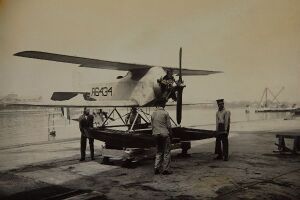Engineering:Caspar U.1
| Caspar U.1 | |
|---|---|

| |
| U.1 under test by the US Navy | |
| Role | Submarine-launched patrol seaplane |
| National origin | Germany |
| Manufacturer | Caspar-Werke |
| Designer | Ernst Heinkel |
| First flight | 1922 |
| Primary user | Reichsmarine |
| Number built | 3 |
The Caspar U.1 (sometimes known as the Caspar-Heinkel U.1) was a 1920s Germany patrol seaplane designed by Ernst Heinkel and built by Caspar-Werke.[1] The U.1 was designed to fit into a cylindrical container to allow it to be carried, then launched from a submarine.[1]
Development
The U.1 was designed to meet a requirement to fit inside a cylindrical container 7.40 metres (24.3 ft) long with a diameter of 1.70 m (5 ft 7 in); this allowed the aircraft to be carried by a submarine.[1] To reduce the time to launch the aircraft, it was built as a cantilever biplane to remove the need to rig struts and wires on assembly.[1] The U.1 had two single-step floats and was powered by a front-mounted 55-horsepower (41 kW) Siemens radial piston engine.[1] The pilot had an open cockpit behind the upper wing which gave a clear view forward.[1] It is claimed that during tests, four men could remove the U.1 from the container and erect it in 1 minute 3 seconds.[1] Two aircraft were bought by the United States Navy for evaluation;[1] these were delivered to Naval Air Station Anacostia in late 1922, and were tested during 1923; one of the aircraft was damaged beyond repair whilst mounted on a truck for a parade.[2]
Operators
 Germany
Germany
- Reichsmarine
 United States
United States
- United States Navy
Specifications
Data from Flight, June 1923[3]
General characteristics
- Crew: Two
- Length: 6.20 m (20 ft 4 in)
- Wingspan: 7.80 m (25 ft 7 in)
- Height: 2.34 m (7 ft 8 in)
- Wing area: 14 m2 (150 sq ft)
- Empty weight: 360 kg (794 lb)
- Gross weight: 510 kg (1,124 lb)
- Powerplant: 1 × Siemens 5-cylinder radial engine, 37 kW (50 hp)
- Propellers: 2-bladed
Performance
- Maximum speed: 145 km/h (90 mph, 78 kn)
- Cruise speed: 121 km/h (75 mph, 65 kn)
- Time to altitude: 7 mins to 1,000 m (3,300 ft)
- Landing speed: 75 km/h (47 mph; 40 kn)
See also
Aircraft of comparable role, configuration and era
- Cox-Klemin XS
- Parnall Peto
- Martin MS
- Yokosuka E6Y
Related lists
- List of United States Navy aircraft designations (pre-1962)
- List of flying boats and floatplanes
References
Notes
- ↑ 1.0 1.1 1.2 1.3 1.4 1.5 1.6 1.7 Orbis 1985, p. 1060
- ↑ Treadwell, Terry (February 1983). "Submarine Aviation". Naval Aviation News (Washington, DC: Naval Air Systems Command) 65 (2): 9. ISSN 0028-1417.
- ↑ "The Caspar sport seaplane". Flight XV (24): 315–6. 14 June 1923. https://www.flightglobal.com/pdfarchive/view/1923/1923%20-%200315.html.
Bibliography
- The Illustrated Encyclopedia of Aircraft (Part Work 1982-1985). Orbis Publishing.
- Herris, Jack (2020). German Aircraft of Minor Manufacturers in WWI: A Centennial Perspective on Great War Airplanes. Gret War Aviation Centennial Series (49). 1: Alter to Korn. n.p.: Aeronaut Books. ISBN 978-1-935881-85-8.
- Passingham, Malcolm (February 2000). "Les hydravions embarqués sur sous-marins" (in French). Avions: Toute l'aéronautique et son histoire (83): 7–17. ISSN 1243-8650.
 |

